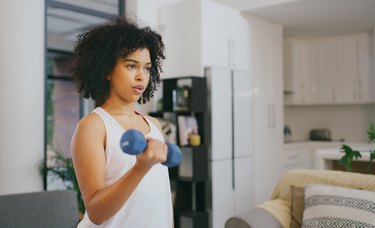
The biceps curl is a classic upper-body exercise targeting the biceps muscles, the muscles on the front of your upper arms. No other muscles are directly involved in a biceps curl, although several muscles assist during the movement.
During the curl exercise, the biceps muscle shortens then lengthens to control the movement of the weight. Here, learn everything you need to know about biceps curl mechanics.
Video of the Day
How to Do a Biceps Curl With Perfect Form
Dumbbell Biceps Curl
- Start standing with your feet hip-width apart, arms at your sides with a dumbbell in each hand.
- Brace your core and, on an exhale, curl the dumbbells up to your shoulders, keeping your elbows close to your sides.
- Lower the dumbbells back down with control.
Tip
You can do biceps curls with a barbell, resistance bands, dumbbells, a cable machine or even household items like water bottles or canned foods. Although the type of resistance changes, the movement is the same.
Understanding Biceps Curl Mechanics
Your biceps muscle contracts both concentrically and eccentrically during the biceps curl. When you curl the weight up, the biceps muscle creates enough force to overcome the external resistance. During this phase of concentric contraction, the muscle fibers shorten, pulling at the elbow joint and lifting your forearm, according to the American Council on Exercise (ACE).
When you lower the weight, the muscle fibers do not create enough force to overcome the external resistance. The fibers lengthen during this eccentric phase to control the descent of the weight, according to the ACE.
With consistent training and a strategic plan to continue challenging yourself, you'll start to see the benefit of biceps curls: stronger, more defined upper arms.
Muscles Worked in Biceps Curls
The biceps curl is a single-joint, isolation movement that only targets the biceps muscle, which runs from your shoulder to your forearm.
However, other muscles, including your brachialis and brachioradialis, small muscles in your upper arm and forearm, assist the biceps muscle, according to the ACE.
Muscles in your upper back contract without shortening or lengthening in order to stabilize your torso, and muscles in your forearm contract without movement to stabilize your wrist joint, according to ExRx.net.
Common Mistakes and Safety Tips
To work the biceps to the best of your ability, it's crucial to avoid common biceps curl mistakes and follow these safety and form tips:
- Keep your shoulders stable throughout the movement. Don't use your shoulders to swing the weights upward.
- Keep your torso stable and upright throughout the curl. This provides a stability challenge for your core muscles and protects your back.
- Don't arch your lower back, which can lead to back pain.
- Make sure to move through your entire range of motion and don't rush your reps.
- Consider trying some biceps curls variations — like hammer curls and Zottman curls — to work different parts of your biceps.
FAQ
Common Questions
Is it OK to do biceps curls every day?
Doing a single exercise every day can lead to overuse injuries and stall your progress. Instead, aim to do biceps curls two to three times a week as part of a well-rounded strength-training program.
How much should you curl?
Beginners can start with anywhere from 5 to 15 pounds for 8 to 12 reps, Carolina Araujo, CPT, a New York-based strength coach, previously told LIVESTRONG.com. More advanced weightlifters might curl anywhere from 20 to 40 pounds for the same rep range (or a little higher). The weight you choose should feel challenging for the last couple of reps in each set, but not so challenging that you compromise your form.
How long does it take to see results from biceps curls?
Muscle growth varies from person to person, but you probably won't see much of a difference from biceps curls (or any new strength exercise you've added to your routine) until about 6 weeks of consistent training, according to a December 2019 study in Environmental Research and Public Health.